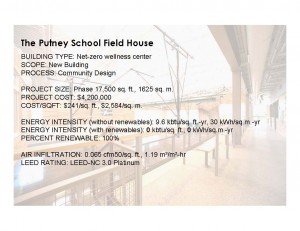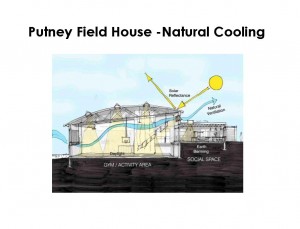I recently had the chance to travel to Montreal and present one of our Vermont projects, the net-zero Putney School Field House, at the international ASHRAE conference. This was an exciting chance for us to share with others how it really is possible to achieve net-zero in the cold climate of Vermont. This was also a great opportunity to learn about other projects, as the session we were presenting in also highlighted two other groups of net-zero building professionals, one from Italy and one from Canada.

Lessons from Across the Border
The Canadian group, which presented a study on high-performance Canadian buildings, i.e., those consuming less than 60% of Energy Code baseline, identified the fact that though there are a significant number of high-performance projects there are only a few of these that are close to net-zero and there are no existing net-zero commercial projects in the country. The presentation highlighted three of these close to net-zero buildings: the Creek Side Community Center in Vancouver, a material testing lab in Hamilton, Ontario and the Earth Ranger Center in Woodridge, which is north of Toronto. What was apparent through the description of these projects is though they were utilizing many of the strategies that we also utilize in our building projects — such as daylighting, low energy equipment and heat recovery technologies — they were definitely missing pieces too. These projects focused quite a bit on the visible technologies of energy efficiency, but through this focus missed some of the places where we see the largest reduction in loads, such as envelope design, including high insulation levels and low air infiltration readings.
Lessons from Across the Ocean
The Italian group focused on a single project, the Leaf House located in Anacona, Italy. This project focused on the goal of its team to analyze the net-zero building process in an effort to better define the term “net-zero energy buildings,” and to inform the process of the International Energy Agency (IEA). An IEA work group has been established to study Net-Zero Energy Buildings to inform international actions related to energy and greenhouse gas requirements in the building industry. To optimize energy use, the Leaf House project uses the most advanced available technologies for the processes of distributing heat and producing electricity from renewable sources. Built as somewhat of a test facility for high performance design, where the major focus of the design was the reduction of CO2 emissions, this house has over 1000 sensors to monitor performance. Even after the installation of this advanced monitoring, this group determined that a more effective strategy of monitoring and a better building automation system could make significant improvements to the energy performance of the building. All in all, the project highlighted a very expensive way to achieve high-performance building design.
Lessons to Bring Back to Vermont
It has always been my point of view that the best high-performance and net-zero building projects are the simplest; They are the ones that take into account beauty in the living condition and contribute to a better way of life for the users. From the experience at the ASHRAE conference, this point was hammered home. What we are doing in Vermont, in a colder climate than any of these other projects were located, is making net-zero work.
Projects such as the Putney School Field House work because they take into account the high-performance building technologies and strategies that are readily available in the marketplace, but in addition, they are designed for a specific place, to integrate into the human experience and to make a better place for the users. Using technologies that are already commonly available in the marketplace means these buildings can work, and they can work cost effectively.

In order to make the best high-performance buildings a reality, the focus of our profession needs to be on design, on building the best teams possible, and on determining when simple out of the box strategies are more cost effective than their advanced technology counterparts.
Related articles
- Net Energy vs Net Zero Energy (brighthub.com)
- IEA will publish new energy projection where Nuclear build to 2035 will only by 180 GWe (nextbigfuture.com)
- Latest Free Publications and Papers from IEA (talkenergy.wordpress.com)
